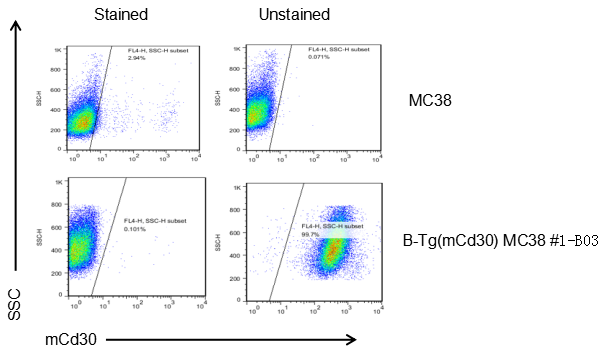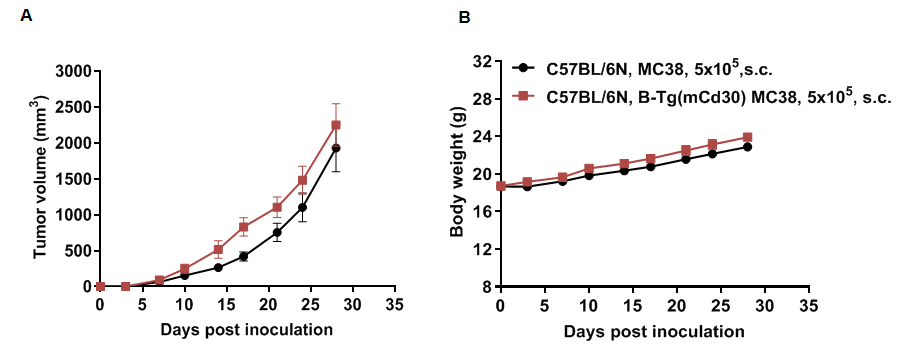中文
B-Tg(mCd30) MC38
|
Common name |
B-Tg(mCd30) MC38 | Catalog number |
321906 |
| Aliases |
Ki; Cd30; Ki-1; D1S166E |
Disease | Colon carcinoma |
|
Organism |
Mouse |
Strain | C57BL/6 |
| Tissue types | Colon | Tissue | Colon |
模型验证
Description
The exogenous promoter and mouse Cd30 coding sequence were inserted into the mouse genome randomly. Mouse Cd30 is highly expressed on the surface of B-Tg(mCd30) MC38 cells.
Application
B-Tg(mCd30) MC38 cells have the capability to establish tumors in vivo and can be used for efficacy studies.
Targeting strategy
Gene targeting strategy for B-Tg(mCd30) MC38 cells. The exogenous promoter and mouse Cd30 coding sequence were inserted into the mouse genome randomly.
Protein expression analysis
Tumor growth curve & Body weight changes

Cd30 expression analysis in B-Tg(mCd30) MC38 cells by flow cytometry. Single cell suspensions from wild-type MC38 and B-Tg(mCd30) MC38 cultures were stained with species-specific anti-Cd30 antibody. Mouse Cd30 was detected on the surface of B-Tg(mCd30) MC38 cells but not wild-type MC38 cells. The 1-B03 clone of B-Tg(mCd30) MC38 cells was used for in vivo experiments.

Subcutaneous homograft tumor growth of B-Tg(mCd30) MC38 cells. B-Tg(mCd30) MC38 cells (5x105) and wild-type MC38 cells (5x105) were subcutaneously implanted into C57BL/6N mice (female, n=6). Tumor volume and body weight were measured twice a week. (A) Average tumor volume ± SEM. (B) Body weight (Mean± SEM). Volume was expressed in mm3 using the formula: V=0.5 X long diameter X short diameter2. As shown in panel A, B-Tg(mCd30) MC38 cells were able to establish tumors in vivo and can be used for efficacy studies.
Copyright © 2024 百奥赛图江苏基因生物技术有限公司. All Rights Reserved
备案号: 苏ICP备2021053911号-1
 苏公网安备:32068402320845号
网站建设:北京分形科技
苏公网安备:32068402320845号
网站建设:北京分形科技
 苏公网安备:32068402320845号
网站建设:北京分形科技
苏公网安备:32068402320845号
网站建设:北京分形科技






 010-56967680
010-56967680 info@bbctg.com.cn
info@bbctg.com.cn